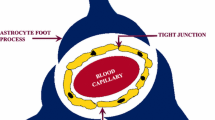Permeability of the blood—brain barrier for protein fractions 50-100 kDa (PF50–100) of Cellex Daily preparation labeled with fluorescent tracer FITC and non-conjugated FITC were compared after intranasal administration of the preparations to healthy rats. Fluorimetrical analysis of the serum and cerebrospinal fluid samples showed that Cellex Daily PF50–100-FITC administered intranasally penetrated into the blood and cerebrospinal fluid with maximum accumulation in 2 h after administration and persists in the circulation for 24 h probably due to binding with plasma proteins. The differences in the kinetic profile of PF50–100-FITC and free FITC indirectly suggest that the major part of the preparation is not degraded within 24 h and FITC is probably not cleaved from the protein components of the preparation. In vivo fluorescence analysis showed significant fluorescent signal in the olfactory bulbs in 6 h after intranasal administration; hence, the preparation administered via this route can bypass the blood—brain barrier. Scanning laser confocal microscopy of rat brain sections confirmed penetration of the high-molecular weight protein fraction PF50–100-FITC into CNS structures. The most pronounced accumulation of the labeled drug was observed in the olfactory bulb in 6 and 12 h after administration. In contrast to free FITC administered in the control group, significant accumulation of PF50–100-FITC in the olfactory cortex and frontal cortex neurons with functionally active nuclei was observed in 6, 12 and 24 h after intranasal administration.
Similar content being viewed by others
References
Baklaushev VP, Pavlov KA, Chekhonin VP. Monoclonal antibodies in diagnostics of high-grade gliomas. Biochemistry (Mosc.) Suppl. Ser. B: Biomed. Chem. 2009;3(2):105-115.
Belskaya GN, Chuprina SE, Vorobyev AA, Gorozha EN, Butorakina TL, Sokolov MA, Izmaylov IA. Cognitive disorders in stroke patients: the possibilities of pharmacological correction. Zh. Nevrol. Psikhiatr. 2016;116(5):33-37. Russian.
Bannunah AM, Vllasaliu D, Lord J, Stolnik S. Mechanisms of nanoparticle internalization and transport across an intestinal epithelial cell model: effect of size and surface charge. Mol. Pharm. 2014;11(12):4363-4373.
Daniel JA, Chau N, Abdel-Hamid MK, Hu L, von Kleist L, Whiting A, Krishnan S, Maamary P, Joseph SR, Simpson F, Haucke V, McCluskey A, Robinson PJ. Phenothiazine-derived antipsychotic drugs inhibit dynamin and clathrin-mediated endocytosis. Traffic. 2015;16(6):635-654.
Deng-Bryant Y, Readnower R, Leung LY, Tortella F, Shear D. Methods of drug delivery in neurotrauma. Methods Mol. Biol. 2016;1462:89-100.
Dey M, Yu D, Kanojia D, Li G, Sukhanova M, Spencer DA, Pituch KC, Zhang L, Han Y, Ahmed AU, Aboody KS, Lesniak MS, Balyasnikova IV. Intranasal oncolytic virotherapy with CXCR4-enhanced stem cells extends survival in mouse model of glioma. Stem Cell Rep. 2016;7(3):471-482.
Donega V, Nijboer C.H, Braccioli L, Slaper-Cortenbach I, Kavelaars A, van Bel F, Heijnen C.J. Intranasal administration of human MSC for ischemic brain injury in the mouse: in vitro and in vivo neuroregenerative functions. PLoS One. 2014;9(11):e112339. doi: https://doi.org/10.1371/journal.pone.0112339.
Donega V, Nijboer CH, van Tilborg G, Dijkhuizen RM, Kavelaars A, Heijnen CJ. Intranasally administered mesenchymal stem cells promote a regenerative niche for repair of neonatal ischemic brain injury. Exp. Neurol. 2014;261:53-64.
Frey WH 2nd. Method of administering neurologic agents to the brain. US Patent 5624898 A. April 29, 1997.
Frey WH 2nd, Danielyan L, Gleiter CH. Methods, pharmaceutical compositions and articles of manufacture for administering therapeutic cells to the animal central nervous system. US Patent 8283160 B2. October 9, 2012.
Khan A, Imam SS, Aqil M, Ahad A, Sultana Y, Ali A, Khan K. Brain targeting of temozolomide via the intranasal route using lipid-based nanoparticles: brain pharmacokinetic and scintigraphic analyses. Mol. Pharm. 2016;13(11):3773-3782.
Kumar S, Ali J, Baboota S. Design Expert® supported optimization and predictive analysis of selegiline nanoemulsion via the olfactory region with enhanced behavioural performance in Parkinson’s disease. Nanotechnology. 2016;27(43). doi: https://doi.org/10.1088/0957-4484/27/43/435101.
McGowan J.W, Shao Q, Vig P.J, Bidwell G.L.3rd. Intranasal administration of elastin-like polypeptide for therapeutic delivery to the central nervous system. Drug Des. Dev. Ther. 2016;10:2803-2813.
Nag S. Morphology and molecular properties of cellular components of normal cerebral vessels. The Blood-Brain Barrier. Nag S, ed. 2003. Toronto.
Narayan R, Singh M, Ranjan O, Nayak Y, Garg S, Shavi GV, Nayak UY. Development of risperidone liposomes for brain targeting through intranasal route. Life Sci. 2016;163:38-45.
Nour SA, Abdelmalak NS, Naguib MJ, Rashed HM, Ibrahim AB. Intranasal brain-targeted clonazepam polymeric micelles for immediate control of status epilepticus: in vitro optimization, ex vivo determination of cytotoxicity, in vivo biodistribution and pharmacodynamics studies. Drug Deliv. 2016;23(9):3681-3695.
Pardridge WM. Why is the global CNS pharmaceutical market so under-penetrated? Drug Discov. Today. 2002;7(1):5-7.
Wei ZZ, Gu X, Ferdinand A, Lee JH, Ji X, Ji XM, Yu SP, Wei L. Intranasal delivery of bone marrow mesenchymal stem cells improved neurovascular regeneration and rescued neuropsychiatric deficits after neonatal stroke in rats. Cell Transplant. 2015;24(3):391-402.
Wei N, Yu SP, Gu X, Taylor TM, Song D, Liu XF, Wei L. Delayed intranasal delivery of hypoxic-preconditioned bone marrow mesenchymal stem cells enhanced cell homing and therapeutic benefits after ischemic stroke in mice. Cell Transplant. 2013;22(6):977-991.
Weiss N, Miller F, Cazaubon S, Couraud PO. The blood-brain barrier in brain homeostasis and neurological diseases. Biochim. Biophys. Acta. 2009;1788(4):842-857.
Author information
Authors and Affiliations
Corresponding author
Additional information
Translated from Kletochnye Tekhnologii v Biologii i Meditsine, No. 3, pp. 196-204, July, 2017
Rights and permissions
About this article
Cite this article
Baklaushev, V.P., Yusubalieva, G.M., Burenkov, M.S. et al. Bioluminescent Study of the Distribution of High-Molecular-Weight Protein Fraction of Cellex Daily Preparation in the Brain after Intranasal Administation. Bull Exp Biol Med 164, 285–292 (2017). https://doi.org/10.1007/s10517-017-3974-9
Received:
Published:
Issue Date:
DOI: https://doi.org/10.1007/s10517-017-3974-9




